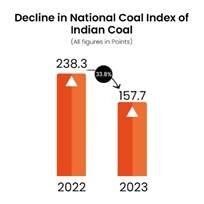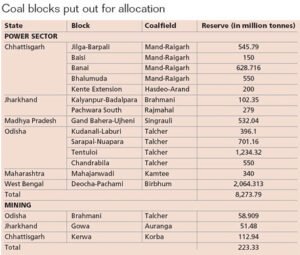Union Minister of Coal, Mines, and Parliamentary Affairs Shri Pralhad Joshi stated that, given the significant rise in local output, imports for the power sector will drop to 2% by 2025.
Speaking yesterday at the opening ceremony for the ninth round of the commercial mine auction held here, Shri Joshi praised Coal India Ltd. and its affiliate firms for their exceptional accomplishment in achieving self-sufficiency in the production and offtake.
The Minister went on to say that there’s a good chance that its global production will surpass one billion tons this year. He further said that India’s coal industry continuously improves the country’s energy security and hence gives our rapidly expanding economy a boost.
The ninth round of commercial coal auctions, that started on 20 December, had the potential to increase the number of private participants in the coal industry, promote efficiency, innovation, and competition while also advancing sustainable development.
This program comes after previously unheard-of successes in the extraction and transportation of coal from captive and commercial mines.
Since 2014, the Ministry’s accomplishments and reforms in this sector have centered on boosting domestic output, reducing dependence on imports, and achieving national coal self-sufficiency.
By taking this important move, the Ministry is demonstrating its continued commitment to implementing sensible reforms that will reshape the country’s energy sector. Following on from earlier successful auctions, the Ministry is resolutely committed to advancing the industry with the upcoming 9th round of Commercial Coal Mine auctions.
Which Coal Mines are being Auctioned?
Eight of the mines are in Chhattisgarh, five are in Jharkhand, one is in Telangana, and twelve are in Madhya Pradesh.
According to the Ministry, 19 mines have only been partially examined, while seven have been thoroughly investigated.
According to an official announcement, 23 of these mines will be governed under the Mines and Minerals (Development and Regulation) (MMDR) Act 1957, while three of these mines will be given under the Coal Mines (Special Provisions) Act 2015 (CMSP).
This time around, there are no limitations on the sale or use, in contrast to earlier commercial mining auctions.
The Ministry of Coal Foreground
The Ministry of Coal stated that it has designed a single window clearance system portal to facilitate the process of obtaining different clearances for the early operationalization of mines. This will eventually lead to an increase in the nation’s coal production through a single gateway, making business easier.
Transparency and equity are ensured by a deliberate switch from the notified price to the National Coal Index, creating a pricing mechanism controlled by the market.
The industry has been able to flourish thanks in large part to the revision of mining laws, which also created fair competition for public and private sector entities and permitted auctions for a range of uses, including personal use and sale.
The government has started a number of projects to boost the amount of the fuel produced domestically in order to fulfill the rising demand for fuel in the rapidly expanding economy.
As of November 2023, the nation has produced approximately 591.40 MT of coal in the current fiscal year, up roughly 13% from 524.72 MT in the same period the previous year.
Compared to the same period in the previous fiscal year, the imports decreased by 5% between April and September 2023 due to a rise in domestic output.
India is the world’s second-largest producer of coal, with a total resource of 344.02 billion tonnes. Over the years, India’s need for power has steadily increased. Since coal accounts for 72% of India’s electricity production, the sector is crucial to the country’s development.
9th Round Coal Mine auctions
The Ministry of Coal said in a statement that it is about to take another big step in its efforts to promote economic growth and energy security when the 9th round of commercial mine auctions was scheduled to began on Wednesday, December 20, 2023.
The ministry stated, “Of the 26 coal mines that will be put up for auction, seven have been fully explored and 19 have been partially explored.”
The states of Telangana, Jharkhand, Madhya Pradesh, and Chhattisgarh are hosts to these mines.
The major guest for the event was Minister of Coal and Mines Pralhad Joshi, while the honouree will be Minister of State for Railways, Coal, and Mines Raosaheb Patil Danve.
In contrast to earlier commercial coal mining auctions, it can be used and sold without any limitations. The ministry stated, “Notably, eligibility criteria have been eliminated, removing any technical or financial barriers for participation.”
This is the ninth round of commercial mine auctions, with 31 mines total—26 under the 9th round and 5 under the second try of the 7th round.
Considering output at the aggregated peak rate capacity level of around 220.90 MTPA, the expected yearly revenue from mining from the mines that have been auctioned off to date is Rs. 33,343 crore. When these mines are completely operational, they would provide direct and indirect employment for almost three lakh people. The operationalization of these mines will require an investment of over Rs. 30,000 crore.
Over the course of the last four years (2018–19, 2019–20, 2020–21, and 2021–22), 68 mines have received ratings of five stars (more than 91%) and 39 mines have placed first, second, and third.
The three categories of Underground Mines (UG), Opencast Mines (OC), and Mixed Mines are used to evaluate each mine’s overall achievements. The star ratings range from Five Stars to No Stars. These seven modules specify a total of 50 evaluation parameters for open-pit mines and 47 for underground mines.
The Auctioning Process
India’s mining industry has changed in terms of the regulatory environment. We have progressed from a previous restrictive paradigm to one where these mining blocks are awarded through a competitive bidding procedure.
Additionally, we have gone from dictating a specified end-use to allowing the commercial selling of the mineral. The private sector was permitted to participate in the 2014 auction-based regime, but only for captive use in their own end-use plants.
The process of conducting commercial coal block auctions involves two stages of online bidding: the first stage involves technical screening and the submission of a competitive initial price offer; the second and final round is when superior price proposals are made.
Auctions for commercial mining are entirely different from the previous system of price, use, and sector restrictions. These days, there are absolutely no such limitations.
The terms and conditions of the auctions are very lenient; they permit participation by new companies in the bidding process, reduce the upfront amount, adjust the upfront amount against royalty, encourage flexibility in the operationalization of mines through liberal efficiency parameters, provide a transparent bidding process.
They permit 100% FDI through the automatic route, and have reasonable financial terms and a revenue sharing model based on the National Coal Index.
The Climate Change Meet and Mining Auctions, Government’s Hypocrite move?
Even after decades of research on its link to climate change, 40% of the world’s CO2 emissions from energy use still come from burning coal. If the electricity sector is to meet the climate goals set forth in the Paris Agreement, it must cease using coal without carbon capture and storage by roughly 2050.
Approximately 8 million people are employed worldwide in the mining sector, which generates over US$900 billion in revenue annually.
India has become a global pioneer in reducing emissions, according to Shri Joshi, who highlighted the country’s clean mining techniques. He emphasized that an incentive of Rs. 6000 crore has been provided for the gasification of coal. According to the Minister, coal PSUs have planted 100 million saplings in recent years to further promote sustainable mining.
With the world leaders just returning from the 2023 UN Climate Change Conference, that commenced from 30 November to 12 December 2023 in Dubai, United Arab Emirates (UAE), the government’s move to emulsify the coal mining business seems quite a hypocritical move.
It doesn’t seem fair to promise a climate improvement when the CO2 emission business is gaining a 13% already.
Nevertheless, our government must act swiftly to cut the consumption without carbon capture and storage and completely stop it over the next several decades because to the urgency of combating climate change.
However, concentrating only on the consequences of carbon combustion that are relevant to the environment and human health, probably won’t be enough to phase out coal. It will be more important that the coal phase out be viewed as fairly and that the procedure takes into account political realities.
More information is required for our government to comprehend who would be impacted by the shift away from coal, how various socioeconomic groups can be fairly paid, and how strong vested interests can be balanced.
Therefore, what is required is a fair and practical transition that limits negative effects on consumers and energy-intensive businesses while also offering respectable work and quality jobs as well as regional economic potential.














